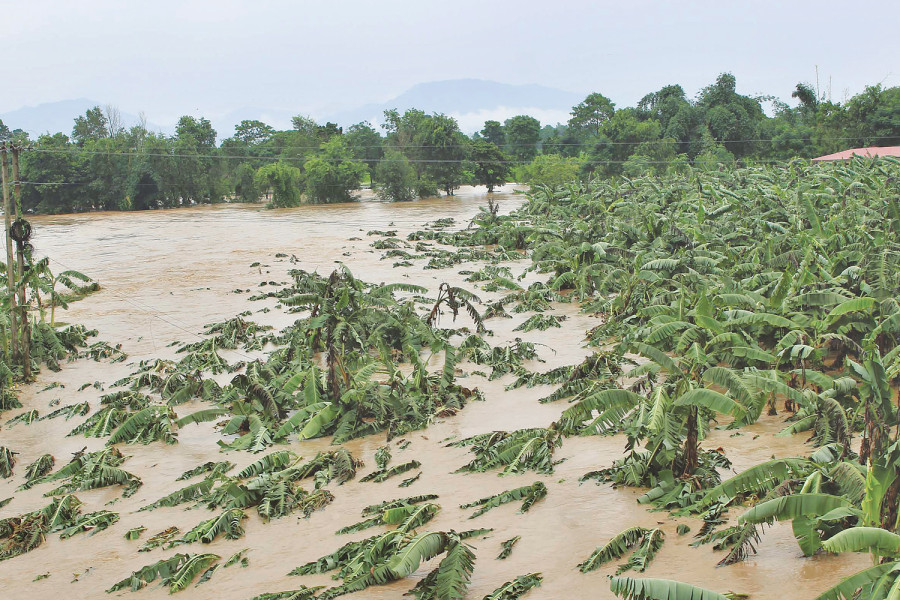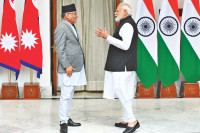Special Supplement
Yearender 2023: Changing climate raises alarm in Nepal
Approximately 80 percent of Nepal’s population is at risk from natural and climate-induced hazards, including extreme heat stress, flooding, and air pollution.
Arjun Poudel
The summer of 2023 was Nepal’s hottest in recorded history.
Damkauli of Nawalparasi in the Tarai observed record-breaking temperatures (43.8 degrees Celsius), which were not observed in the last 44 years.
With the maximum temperature reaching close to 44 degrees Celsius, many Tarai districts witnessed heat waves, triggering a record number of wildfires and crop losses.
Unprecedented fires raged in the summer’s extreme conditions. A government report shows that 2023 was one of the worst years in Nepal for the environment with more than 5,500 incidents of forest fires.
More than 2,800 forest fires were blazing across Nepal on April 19, the highest number in a day, which put the capital city of Kathmandu on alert as it turned into one of the most polluted cities in the world, according to the Air Quality Index.
“Heatwaves triggered by prolonged drought have increased the forest fires in Nepal. We have been witnessing a rapid surge in forest fires over the years,” said Sundar Sharma, a forest fire expert.
“Studies show that forest fires are a direct effect of climate change the planet is experiencing.”
Another direct consequence of climate change is being seen in the unseasonal rainfall the country has been experiencing for the past few years.
In 2021, the country suffered heavy rainfalls that occurred outside the monsoon window in mid-October.
The rains started on October 17, 2021, in the western part of Nepal gradually moving east. On October 19, landslides and floods triggered by heavy rainfall claimed more than 100 lives, damaged roads and bridges and other physical infrastructure in various districts.
Sudurpaschim Province was hit hardest by the disaster.
Kanchanpur, Kailali, Doti, Baitadi, Dadeldhura, Baitadi and Bajhang districts were hugely affected. Mahakali, Karnali and Seti rivers recorded the highest water flow in decades, causing huge loss of life and properties.
That year, farmers alone suffered crop losses of more than Rs5 billion, according to the agriculture ministry statistics.
Manang and Mustang, the two mountainous districts in Gandaki province, have seen disastrous effects of climate change of late.
Kagbeni of Mustang district witnessed a massive flood in mid-August this year. The flood triggered by extremely heavy rainfall swept away around three dozen houses and displaced more than 150 people.
A similar incident occurred in 2021 in Chame, the district headquarters of Manang, in which a massive flood caused huge damage to private as well as public properties, and infrastructure including a school building.
While the mountainous region of the country suffered from unseasonal heavy rainfall, the Tarai region has been reeling under an unusual mid-monsoon drought. The population of Tarai are facing not only the shortage of water to irrigate their fields but has also started encountering drinking water shortage due to acute water scarcity.
Wells, hand pumps and borewells in the areas have dried up. Due to a lack of rainfall for a long time and scorching heat, life has become difficult in the Tarai plains.
The unusual weather conditions deviating significantly from the reasonably expected is a strong indication of the effects of climate change in Nepal, and globally.
Scientists now refer to climate change as a full-blown emergency globally and for a country like Nepal, where there are no proper resources to tackle the climate events, a catastrophe awaits.
Floods spread across the foothills of the Himalayas and bring landslides, leaving tens of thousands of houses and vast areas of farmland and roads destroyed. These disasters have now become a common annual occurrence.
While Nepal has made short- and long-term strategies and policies to deal with the adverse impacts of climate change, it still lacks in the implementation process, says Manjit Dhakal, a climate expert. “Nepal’s approach to adopting preemptive measures has been lackadaisical so far,” he said.
“Whatever the policies on mitigation and adaptation we have made, their implementation is poor.”
The risk of extreme events is growing and affects people’s lives as well as the country’s economy.
Nepal is highly vulnerable to climate change and natural disasters and faces both extreme and slow-onset climate-related hazards.
According to the World Bank’s latest report, Nepal’s climate vulnerabilities emerge from a combination of fragile mountainous topography and ecosystems, highly variable monsoon-driven hydrology, unplanned settlements, and a lack of resilient infrastructure.
Nepal ranks as the 10th most affected country in the world according to the Climate Risk Index.
Approximately 80 percent of Nepal’s population is at risk from natural and climate-induced hazards, including extreme heat stress, flooding, and air pollution, says the World Bank.
Vulnerable communities, particularly those living in poverty, in remote areas, and working in subsistence agriculture, are at the highest risk. Earthquakes and flood risk are the most damaging natural hazards to date, while floods and landslides were the most frequent hazards over the past 40 years, the report says.
The number of flood events has doubled in recent years; storms, erosion, and landslides are also on the rise, resulting in loss of life and livelihoods.
Heavy monsoon floods and landslides in 2020 caused hundreds of deaths, displaced thousands of people, and damaged many roads across the country. Mountains are warming faster than the plains, triggering the melting of ice and permafrost and an increase in the risk of landslides.
Incidences of dry spells, droughts, forest fires, heatwaves, flash floods, and disease outbreaks are increasing along with slow-onset risk.
The report says that winters are projected to be drier and monsoon summers wetter, with up to a threefold increase in rainfall. The number of people in Nepal annually affected by river flooding caused by climate change could more than double to around 350,000 in 2030 (from 157,000 in 2010).
The economic impact of this flooding could triple. Warming threatens the future of Nepal’s high mountain glaciers, which are a critical supply of freshwater to the region.
In Kathmandu, water stress is so severe that piped supply is reported to meet less than 32 percent of household demand in the monsoon and 19 percent in the dry season, according to the report.
Declining availability of water comes at critical cropping times, decreasing soil moisture, with prolonged droughts resulting in crop failures and productivity losses. In the energy sector, hydropower makes up 90 percent of Nepal’s domestic electricity generation.
Currently, all but one hydroelectric plant is run-of-river; its productivity is impacted by river runoff volume and sedimentation caused by poor land and forest management as well as extreme weather events.
Apart from widespread damage to roads, bridges, and public properties, hydel projects (both in operation and under construction) in the flood and landslide-hit districts of Koshi Province—Sankhuwasabha, Panchthar, Bhojpur and Taplejung—incurred massive damage.
At least 30 hydropower projects in eastern Nepal suffered damage estimated at around Rs8.5 billion due to floods and landslides during the first spell of the monsoon this year.
According to the Independent Power Producers Association of Nepal (IPPAN), the Hewa Khola Hydropower Project was built by analysing the past 100 years’ data on the river’s normal flow and floods.
However, building hydel projects based on 100 years of water data doesn’t ensure their safety, as weather extremes have been escalating due to the effects of climate change.
Due to prolonged drought in the winter and dry seasons, the production of almost all hydel projects was reduced to around 30 percent of the total capacity.
Hydropower is not only the main source of energy in the country but also has huge export potential. The government aims to export 10,000 megawatts of electricity in the next 10 years.
This represents a potential vulnerability in the context of uncertain future precipitation regimes, glacial melting, and potential increases in the risks of landslides and glacial lake outburst floods (GLOFs).
Lack of climate considerations in the built environment and urban planning exposes cities and major trade corridors—where much of the economy is concentrated—to greater risks.
Nepal’s infrastructure is vulnerable to heavy rainfall, flooding, and landslides, the frequencies and intensities of which are increasing.
90 percent of Nepal’s movement of passengers and goods takes place on road transport networks. In the fiscal year 2019-20, road infrastructure incurred damages worth over Rs2 billion ($16.4 million).
Climate change has inadvertently gone on to affect public health as well.
Vector-borne diseases like dengue have started to emerge in the areas considered non-endemic in the past.
This year too, all 77 districts including all mountainous districts reported a dengue outbreak. At least 20 died and over 51,000 people tested positive for the virus.
Public health experts say that the real number of infected persons could be several times higher, as the government’s case reporting system is ineffective and more than 80 percent of cases are asymptomatic.
Infection of the deadly virus has continued even during the winter, indicating that the virus has become endemic in the country, according to experts.
However, despite the negative implications of climate change the country has been experiencing, it witnessed some positive changes this year which could lead to potential breakthroughs in addressing the climate crisis.
The United Nations Secretary-General’s visit and his appeals to the global community for urgent action to protect the mountains and glaciers helped to draw global attention to the catastrophic consequences of climate change for which the country is not responsible.
“It’s time to stop the looting and generating climate change because we must preserve these wonderful mountains and these wonderful glaciers,” Guterres told media persons at Pokhara Airport. “And it’s essential to support Nepal and … other countries that do not contribute to climate change but suffer the consequences.”
Guterres urged the global community to come to Nepal to see the catastrophic effects of climate change, which helped to draw global attention towards the brunt of the climate crisis Nepali people have been encountering, climate experts believe.
Climate scientists say Nepal’s representation in the COP28 meeting and commitments of the government to deal with the impacts of climate change can be also taken as positive developments.
Prime Minister Pushpa Kamal Dahal himself attended the United Nations summit on climate change COP-28, in which he called for climate justice, backed by compensation and funding for vulnerable countries.
Addressing the COP event, Dahal said that climate change impacts all, irrespective of the colour, caste, and social well-being of the people.
“Therefore, I, as the prime minister of Nepal, appeal to the international community to ‘save our mountains to save ourselves, ” Dahal had said. “Mountains are tortured by rising temperatures. Save them first!”




 18.12°C Kathmandu
18.12°C Kathmandu










